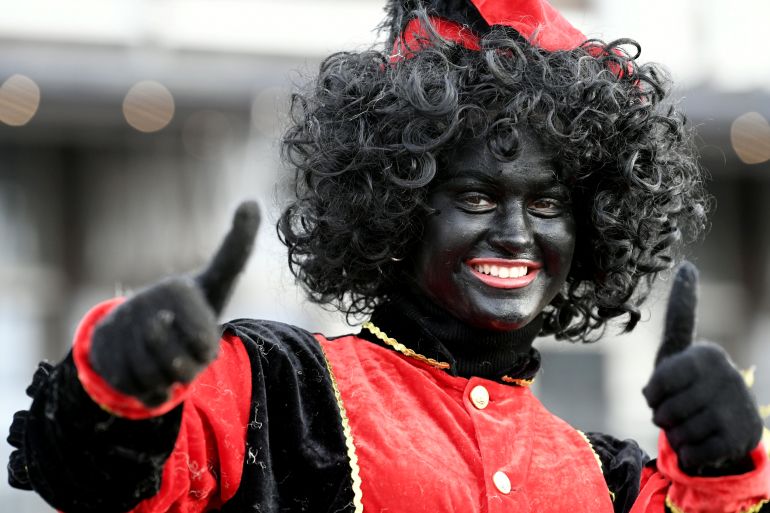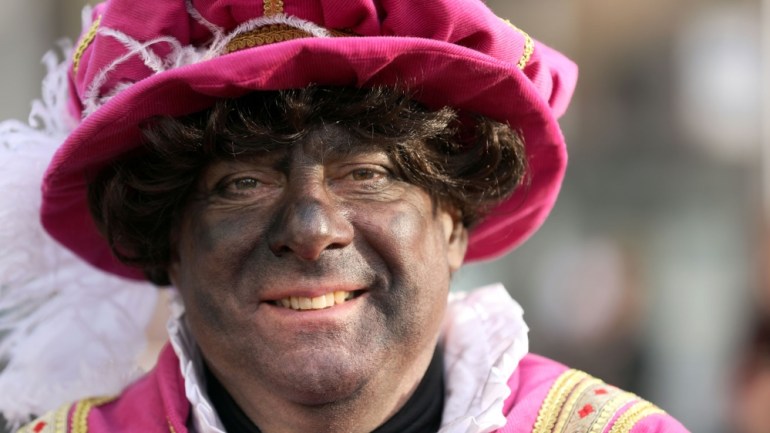Black Pete: Is time up for the Netherlands’ blackface tradition?
The Netherlands faces tough questions over its yearly festival amid a global anti-racist movement.

It seems that the winds of social change may have finally reached the shores of the Netherlands.
Following years of demonstrations against Black Pete, and amid the recent Black Lives Matter protests, the controversial blackface Sinterklaas tradition has largely faded from view this year.
Keep reading
list of 3 itemsBlack Pete tradition ‘Dutch racism in full display’
Black Pete: Blackface character stirs debate during Dutch holiday
And with COVID-19 cancelling parades, Sinterklaas’s arrival by boat this year, with his helper Black Pete, was a much-muted event.
“This year has definitely been the year of change,” said Jerry Afriyie, one of the founders of the Dutch anti-racist organisation Kick Out Black Pete.
“We used to be called terrorists, we are now mainstream. The fight today is about whether the change is going to be done right.”
Black Pete, or Zwarte Piet as he is known in the Netherlands, is a holiday tradition dating back to the 19th century that depicts a helper of Saint Nicholas dressed in blackface with an Afro wig, large red lips and golden hoop earrings. Many see Black Pete as a racist symbol harkening back to the minstrel shows in the United States, and the Netherlands’ participation in the slave trade.
After the death of George Floyd in the US, a moment which prompted a global anti-racist movement, Prime Minister Mark Rutte, who himself has defended Black Pete and dressed in blackface, said: “I expect in a few years there will be no more Black Petes,” as he acknowledged “systemic problems” with racism in Holland.
“The politicians, they want to be on the right side of history,” said Afriyie, adding officials are now contacting him and others in the movement.
“I welcome that the prime minister has finally come to the conclusion that we have a racism problem in the Netherlands, but it has been years and he has not taken a stand, and that has been dangerous.”
According to recent polls, national support for Black Pete is diminishing, particularly in large cities, where Black Pete appears in multicolours, or as Chimney Pete with dark smudges on his face, a compromise narrative that envisions Sinterklaas’s helper as covered in soot because he came down the chimney.
“Nine out of 10 schools have changed their Black Pete decorations to Chimney Pete and have changed the songs as well.”
While Afriyie welcomed the moves, he warned Chimney Pete is racist as well.
“We seeing them stepping away from racism to racism lite,” he said. “They say of the darker Chimney Petes that he has gone through the chimney more times.”
‘Every Black person will tell you that they were called Black Pete in their childhood’
Changing the tradition of Black Pete is a difficult conversation for Dutch citizens.
Myrco Benschop, a Black student who works part-time in a shop in Amsterdam Southeast, a largely Black and immigrant neighbourhood, hates being asked if any Black Pete items are being sold this year.
“I think that every Black person you ask will tell you that they were called Black Pete a few times in their childhood,” he said.
“I said I’m on the fence on the matter first because the argument of ‘It’s our Dutch culture’ is so ingrained in me.
“It’s not hard to come up with an alternative for Black Pete. You know, if you can convince a child that Sinterklaas exists, you can also convince him Pete took a shower and is no longer Black.”
Margaret Kwidama was born on Curaçao and has lived in Amsterdam for 25 years.
“On our island Zwarte Piet is normal,” she said. “The children are used to him, they get so excited when you mention Sinterklaas and Zwarte Piet. That’s why I think the Zwarte Piet tradition should stay. I also dress up as Zwarte Piet for the children. Things such as slavery are in the past. You have to let go and move on. What’s in the past is in the past.”
Recently there was a flurry of reporting that Dutch libraries had removed books featuring Black Pete from their shelves. But the Association of Public Libraries of the Netherlands later released a statement clarifying that there was no national policy on Black Pete.
“Some libraries choose to keep books in which Zwarte Piet plays a role in the collection, some libraries remove it from the collection and others include them in the warehouse, from which they remain available on request,” the statement read. “Each library chooses its own pace. In addition, anyone who is a member of a library can access the collections of other libraries.”
And there are plenty on the far right who are not content to watch the Black Pete tradition go gently into the night.
Geert Wilders, the far-right politician who has been charged with inciting hatred and discrimination, tweeted: “Only one is the real one. Throughout NL. It is not grey or white and it does not have a soot smear but it is black. That is our tradition and culture and has nothing to do with racism! Long live Zwarte Piet!!”

Afriyie was planning anti-Black Pete protests in Eindhoven last week, but the rally was cancelled because the right-wing, anti-immigration and anti-Islamist group Pegida also sought a licence to demonstrate in support of Black Pete.
“It was very unsafe. We were attacked in the last two years, last year with fireworks,” he said, claiming authorities previously wanted to put them in the same square at the same time, “like, ‘You fight it out’.”
While declining support for Black Pete is heartening, he warned: “People supporting Black Pete have been radicalised and are supported by extremists and hooligans.”

Pegida spokesman: ‘When I dress up as Zwarte Piet most people like it’
On Thursday, Mitchell Esajas, a co-founder of The Black Archives, which documents Dutch Black history and culture, was in parliament to discuss policies around discrimination and racism in the Netherlands, when his phone buzzed.
“I received pictures from my colleague, who had just arrived at the archive.”
A mural they had commissioned on the wall of the building of Black resistance fighters and heroes from the Surinamese community, including anti-colonialist author Anton de Kom, had been vandalised with white paint painted over the faces.
“They also put stickers on our door and the mural that said ‘Chimney Pete is white genocide’,” said Esajas.
“Chimney Pete is a compromise. It does not include the racist elements, but there are a lot of Dutch people who think changing the tradition is an attack on their culture. Because there is change, the extreme right is getting more radicalised and they are prone to use violence. A lot of politicians are underestimating the radicalisation of the extreme right.”
Esajas said right-wing social media accounts have been doxing – researching and posting private information on – peaceful protesters, including putting their names and personal information online.
“The stickers they put on our door, we have only seen them once before when a group of white extremists, the Zwarte Pieten Actiegroep, went to the home of the Dutch rapper, Akwasi, who gave a speech at the Black Lives Matter protest, and they went in blackface and left behind exactly these stickers.”
Edwin Wagensveld, a member and spokesperson of Pegida who organised the Eindoven pro-Black Pete counter-protest this year, acknowledged that “football hooligans” show up to anti-Pete protests, but claims his group is against violence, adding intimidation comes from both sides.
He said he welcomes dialogue but said the Kick Out Black Pete movement is not just about Black Pete, it’s “like the Black Panther movement”.
“Kick Out Black Pete says Zwarte Piet is a symbol of something bigger, he said. “No one would deny that racism exists on the grounds of skin colour or religion. But this organisation is also against Chimney Pete. So we basically have to give up a children’s festivity for way more than just the figure of Zwarte Piet.”
Wagensveld disagrees with the prime minister’s statement that Black Pete will disappear, and disputes the idea that people want the tradition to end.
“Rutte has said that there is change happening in the Netherlands, but I think this change is not voluntary. We (as Pegida) see there is forceful pressure. There is fear, especially among entrepreneurs. Shopkeepers are afraid to be linked to Black Pete. People don’t want to see change by force, so we see resistance growing and we are getting more and more support.”
Wagensveld does not believe there is systemic racism.
“Eighty to 90 percent of the Dutch population see Zwarte Piet as non-racist,” he claimed. “When I dress up as Zwarte Piet most people like it … Black Pete is absolutely not racist.”
For Afriyie, “the problem is white people are deciding what is racist, and it is not up to them to decide, it is up to Black people to say what is racist.”
Building on the success of the Kick Out Black Pete movement, Afriyie will help launch a new movement on December 10, International Human Rights Day, a coalition of 15-20 groups focused on the broader goal of Dutch civil rights and ending systemic racism.
“We have drafted a Manifesto for Black Emancipation that will be presented on December 10,” said Esajas, also a member of Kick Out Black Pete, “and this Sunday there will be an anti-racism protest in the Hague.”